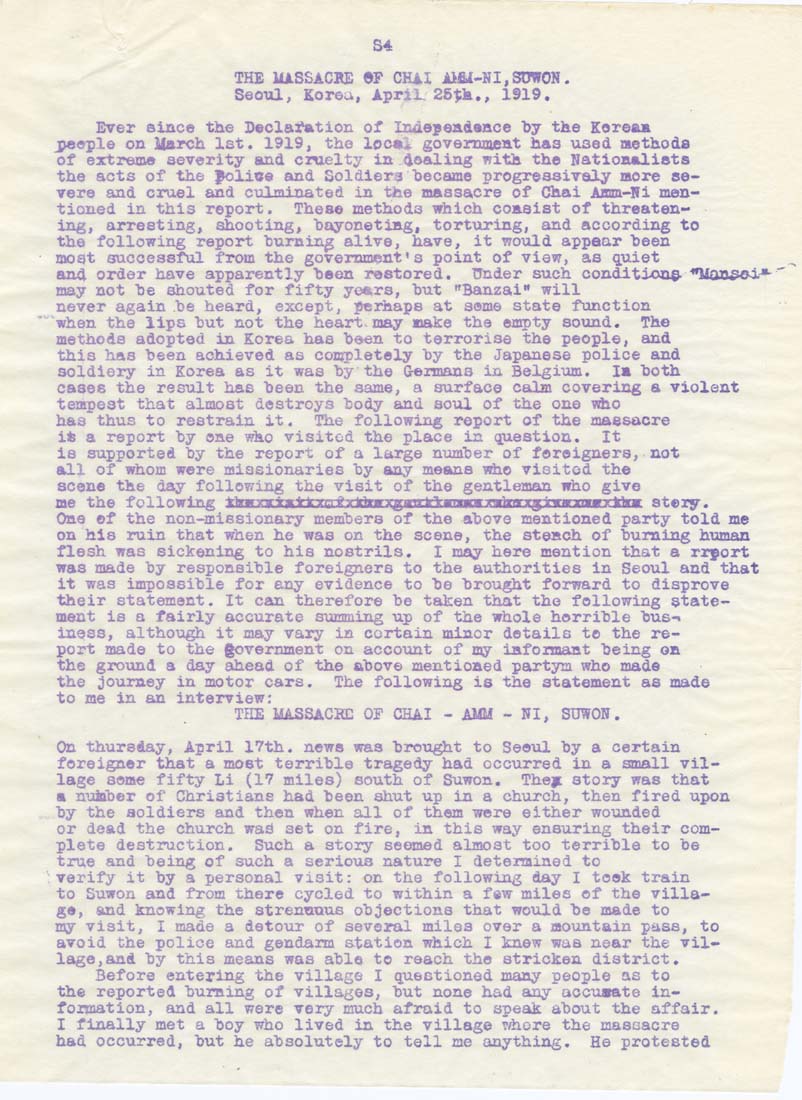S4
THE lUSSACBE «P CHAI li&i-NI, SDWON.
Seoxd, Korea, April, 25th., 1919.
Ever since the Deola3?ation of ladepeadeace by the Koream
jjcople on Karch 1st. 1919, tho lec»i. governmeat has used methods
of extreme severity and c«ielty in dealing with the Nationalists
the acts of the folios and Soldiers became progressively more se¬
vere and cruel and culminated in the massacre of Gb&i Ama-Hi men¬
tioned in this report. Theae methods which coasist of threaten¬
ing, arresting, shooting, bayoneting, tortviring, and according to
the following report burning alive, have, it would appear been
most successful from the govenamsnt's point of view, as quiet
and order have apparently been restored. Under such condition©- ^Uoa^odJ'
may not be shouted for fifty ye»rs, but "Banzai" will
never again be heard, except, perhaps at some state function
when the lips but not the heart, may make the empty sound. The
methods adopted in Korea has been to terrorise the people, and
this has been achieved as completely by the Japanese police and
soldiery in Korea as it was by the Germans in Belgium, la bo-th
cases the result has been the same, a surface calm covering a violent
tempest that almost destroys body and soiil of the one fldio
has thus to restrain it. The following report of -the massacre
i* a report by ©ae who visited the place in question. It
is supported by the report of a large number of foreigners, not
all of whom were missionaries by any means Who visited the
scene the day following the visit of the gentleman who give
me the following MMuauattimi (?xJt]l>a3q;arTr>r1r«TnoKxadnat;^iiiii»iMEcMnt stezy.
One ©f the non-missionary members of the above mentioned party told me
on his ruin that when he was on the scene, the steach of burning human
flesh was sickening to his nostrils. I may here mention that a rijort
was made by responsible foreigners to the authorities in Seoul and that
it was impossible for any evidence to be brought forward to disprove
■their statement. It can therefore be taken that the following state¬
ment is a fairly accurate summing up of the whole horrible bus-»
iness, although it may vary in certain minor details to the re¬
port made to the government on accoiint of my iafoimaat being oa
the ground a day ahead of the above mentioaed partym who made
the journey in motor cars. The following is the statement as made
to me in an interview:
THE MASSACEE OP CHAI - AMM - NI, SDWON.
On thursday, April 17th, news was broTight to Seetil by a certain
foreigner that a most terrible tragedy had occurred in a small vil¬
lage some fifty Li (17 miles) south of Suwon. Thep stoiy was that
a nuiiber of Christians had been shut up in a church, then fired upon
by the soldiers and then when all of them were either wounded
or dead the church waS set on fire, in this way ensuring their com¬
plete destruction. Such a story seemed almost too terrible to be
true and being of such a serious nature I detenained to
verify it by a personal visit: on the following day I toek train
to Suwon and from there cycled to within a few miles of the villa¬
ge, and knowing the atrennuus objections that would be made to
my visit, I made a detovir of several miles over a mountain pass, to
avoid the police and gendarm station which I knew was near the vil¬
lage, and by this means was able to reach the stricken district.
Before entering the village I questioned many people as to
the reported burning of villages, but none had any aoctiaate in¬
formation, and all were very much afraid to speak about the affair.
I finally met a boy who lived in the village Tdiore the massacre
had occurred, but he absolutely to tell me anything. He protested
|








